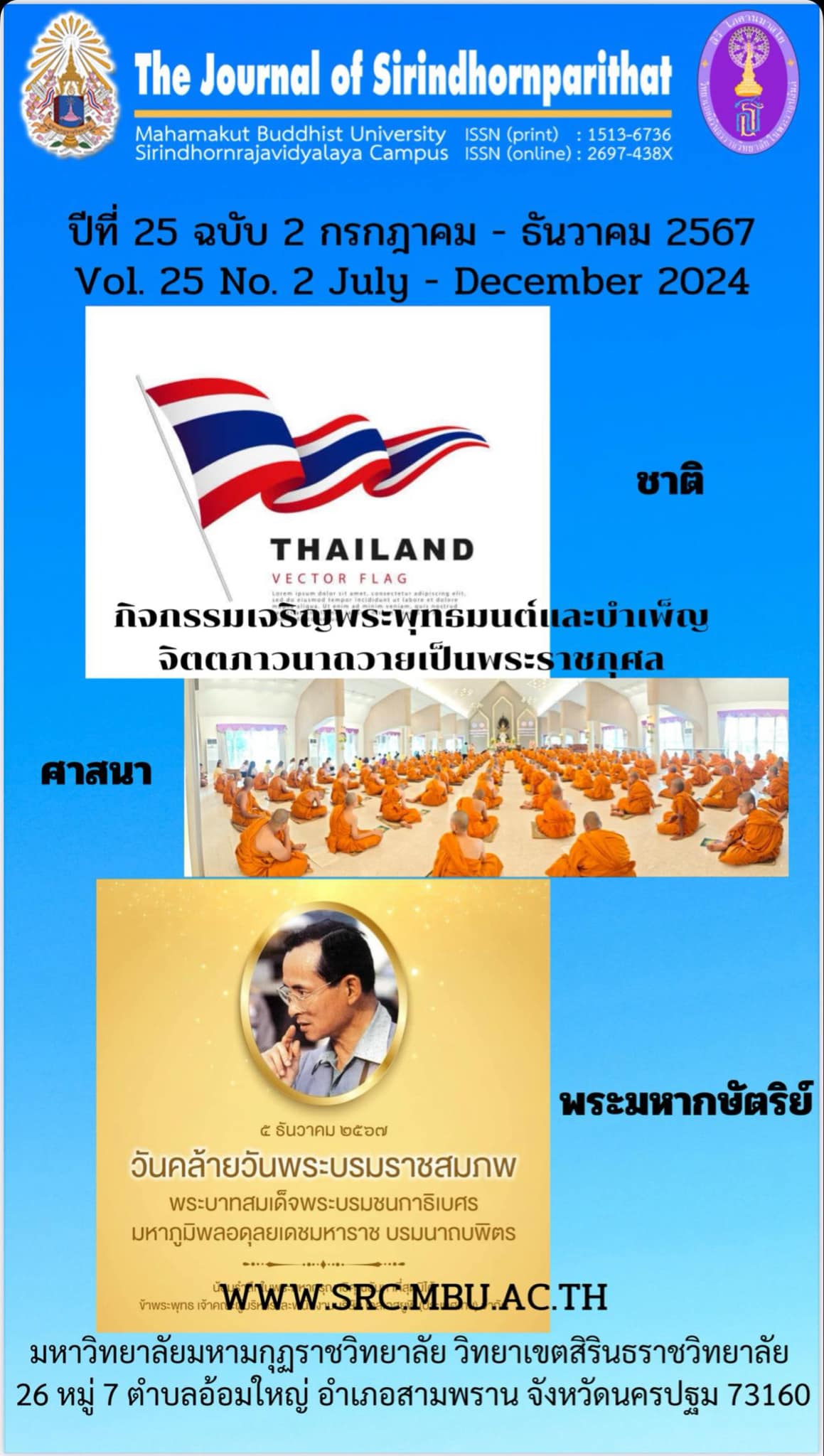The Administration Guidelines for an Innovative Organization of the Office of the Private Education Commission
Keywords:
Innovation, Management, Innovative OrganizationAbstract
This research aimed to study: 1) the current state and the desirable state of administration to become an innovative organization of the Office of the Private Education Commission (OPEC) 2) the needs and necessities of the administration to become an innovative organization of the OPEC, and 3) to propose administration guidelines for becoming an innovative organization of the OPEC. Mixed method was used in this research. In quantitative method, the population was 267 personnel of the OPEC. The sample group was 159 people using the sample size of Craigie and Morgan's table. The sampling was stratified random sampling and the data were collected with questionnaires. The mean and standard deviation were used in the statistical analysis, and the priorities of the necessary needs were analyzed by calculating the Priority Needs Index (PNI). In the qualitative method, data were collected with a semi-structured interview form and used in-depth interviews with 5 people derived by purposive sampling, and the data were analyzed by content analysis. The result of the research indicated that: 1. The overall current state of the administration to become an innovative organization of the OPEC was at a moderate level. The overall desirable condition was at a high level. 2. The order of PNI of the administration to become an innovative organization of the OPEC were able to be arranged in 3 priorities as follows: 2.1) personnel development, 2.2) knowledge management and communication, and 2.3) values and organizational culture. 3. The administration guidelines to become an innovative organization of the OPEC should pay attention to 3 issues. The first one was personnel development. Personnel should change their thinking processes in work, have a positive mindset in creating innovations, and organization should support personnel in their learning. The second one was knowledge management and communication. The organization should have a current and accurate knowledge base that is useful and can be applied to the work. The organization should use technology to help collect, publicize, create communication channels within the organization clearly and quickly to keep up with the current situation. The last one was values and organizational culture. The organization should communicate about the objectives and work goals with personnel to create awareness, learning process to help them realize the importance of innovation in job development.
References
กรกต ขาวสะอาด. (2564). การพัฒนารูปแบบการบริหารเพื่อการเป็นองค์การนวัตกรรมในสถานศึกษาขั้นพื้นฐาน (วิทยานิพนธ์ปรัชญาดุษฎีบัณฑิต). นครปฐม: มหาวิทยาลัยราชภัฏนครปฐม.
ขวัญชนก แสงท่านั่ง. (2563). รูปแบบการพัฒนาสถานศึกษาสู่องค์กรแห่งนวัตกรรม สำหรับ สถานศึกษาขั้นพื้นฐาน. วารสารสังคมศาสตร์และมานุษยวิทยาเชิงพุทธ. 5(7): 153-168.
เทพรัตน์ พิมลเสถียร. (2560). นวัตกรรมและทรัพย์สินทางปัญญา. กรุงเทพมหานคร: ซีเอ็ดยูเคชั่น.
ธนัสถา โรจนตระกูล. (2563). การพัฒนารูปแบบการเป็นองค์การแห่งนวัตกรรมของมหาวิทยาลัยราชภัฏ ในประเทศไทย. วารสารวิชาการวิทยาลัยบริหารศาสตร์ มหาวิทยาลัยแม่โจ้. 3(2): 1-17.
ธนิสร บุญโชติ. (2564). VUCA ในโลกการทำงานสมัยใหม่: 4 เทคนิครับมือความไม่แน่นอนสำหรับผู้นำยุคใหม่. สืบค้น 24 มกราคม 2565, จากhttps://th.hrnote.asia/orgdevelopment/vuca-for-leader-in-future-work-03032021/
นันทวัน แก้วปาน. (2563). แนวทางการพัฒนาความเป็นองค์การนวัตกรรมของสำนักงานขนส่งจังหวัดในเขตภาคกลางตอนล่าง. ปริญญาบริหารธุรกิจมหาบัณฑิต. นครปฐม: มหาวิทยาลัยราชภัฏนครปฐม.
สินีนุช ศิริวงศ์. (2560). วิทยาลัยพยาบาลกองทัพเรือ:การเดินทางสู่การเป็นองค์กรแห่งนวัตกรรม. สืบค้นเมื่อ มกราคม 27, 2565, จาก https://he01.tci-thaijo.org/ index.php/nmdjournal/ article/view/115966/89401.
นิศาชล ฉัตรทอง. (2561). บริบทภาครัฐไทยกับการก้าวเข้าสู่องค์กรแห่งนวัตกรรม. สืบค้น 27 มกราคม 2565, จาก https://so03.tci-thaijo.org/index.php/oarit/article/download/137488 /102336/
นำพล ม่วงอวยพร. (2561). การขับเคลื่อนนวัตกรรมในองค์กรภาครัฐ (M.P.A , D.P.A.). สืบค้น 27 มกราคม 2565, จาก http://rcim.rmutr.ac.th/?p=11572
ปานชนก ด้วงอุดม. (2562). การศึกษาสภาพการเป็นองค์กรนวัตกรรมของสถานศึกษา ตามความคิดเห็นของผู้บริหารสถานศึกษา สังกัดสำนักงานเขตพื้นที่การศึกษาประถมศึกษา พระนครศรีอยุธยา เขต 2. ปริญญาครุศาสตรมหาบัณฑิต. อยุธยา: มหาวิทยาลัยราชภัฏพระนครศรีอยุธยา.
มรกต จันทร์กระพ้อ. (2562). การสร้างองค์การแห่งนวัตกรรมเพื่อขับเคลื่อนสู่ความเป็นเลิศขององค์การ. วารสารนักบริหาร. 39(1): 52-66.
วัฒนชัย ศิริญาณ. (2560). รูปแบบที่ส่งเสริมให้เกิดองค์กรแห่งนวัตกรรมของมหาวิทยาลัยราชภัฏ ในเขตภาคตะวันออกเฉียงเหนือ. วารสารมนุษยศาสตร์และสังคมศาสตร์ มหาวิทยาลัยราชภัฏอุบลราชธานี. 9(1): 111-124.
สุภาภรณ์ เหล่าศรีรัตนา. (2564). แนวทางการพัฒนาความเป็นองค์การนวัตกรรมของศาลยุติธรรมในสังกัดสำนักศาลยุติธรรมประจำภาค 7. วิทยานิพนธ์บริหารธุรกิจมหาบัณฑิต. นครปฐม: มหาวิทยาลัยราชภัฏนครปฐม.
สรนาถ รัตนโรจน์มงคล. (2560). อนาคตของการทำงาน สิ่งที่องค์กรควรเตรียมรับมือ. สืบค้น 23 มกราคม 2565, จาก https://www.marketingoops.com/news/biz-news/future- of-workplace/
สำนักงานคณะกรรมการพัฒนาการเศรษฐกิจและสังคมแห่งชาติ. (2560). แผนพัฒนาเศรษฐกิจและสังคมแห่งชาติ ฉบับที่ 12 (พ.ศ. 2560–2564). กรุงเทพมหานคร: สำนักงานคณะกรรมการ พัฒนาการเศรษฐกิจและสังคมแห่งชาติ สำนักนายกรัฐมนตรี.
สำนักงานนวัตกรรมแห่งชาติ (องค์การมหาชน). (2562). การจัดการสู่องค์กรนวัตกรรม. กรุงเทพมหานคร: สำนักงานนวัตกรรมแห่งชาติ (องค์การมหาชน).
สำนักวิจัยและพัฒนาระบบงานบุคคล สำนักงาน ก.พ. (2560). รายงานสถานภาพการบริหารทรัพยากรบุคคลของข้าราชการพลเรือน ปีงบประมาณ 2559. กรุงเทพมหานคร: สำนักงานคณะกรรมการข้าราชการพลเรือน.
Aboramadan, M., Albashiti, B., Alharazin, H. and Zaidoune, S. (2020). Organizational culture, innovation and performance: a study from a non-western context. Journal of management Development. 39(4): 437-451.
Higgins, J.M. (1995). Innovate or evaporate: Test & improve your organization’s IQ – Its innovation quotient. New York: New Management.
Riveras-León, J. C. & Tomàs-Folch, M. (2020). The Organizational Culture of Innovative Schools: The Role of the Principal. Journal of Educational Sciences. 2(42): 21-37.
Sherwood, D. (2001). Smart things to know about innovation & creativity. Oxford: Capstone.
Tidd, J., Bessant, J., & Pavitt, K. (2001). Managing innovation: Integrating technological market and organizational change. Chicester: Wiley.
Downloads
Published
Issue
Section
License
Copyright (c) 2024 Mahamakut Buddhist University

This work is licensed under a Creative Commons Attribution-NonCommercial-NoDerivatives 4.0 International License.
บทความที่ได้รับการตีพิมพ์เป็นลิขสิทธิ์ของ มหาวิทยาลัยมหามกุฏราชวิทยาลัย วิทยาเขตสิรินธรราชวิทยาลัย
ข้อความที่ปรากฏในบทความแต่ละเรื่องในวารสารวิชาการเล่มนี้เป็นความคิดเห็นส่วนตัวของผู้เขียนแต่ละท่านไม่เกี่ยวข้องกับหาวิทยาลัยมหามกุฏราชวิทยาลัย วิทยาเขตสิรินธรราชวิทยาลัย และคณาจารย์ท่านอื่นๆในมหาวิทยาลัยฯ แต่อย่างใด ความรับผิดชอบองค์ประกอบทั้งหมดของบทความแต่ละเรื่องเป็นของผู้เขียนแต่ละท่าน หากมีความผิดพลาดใดๆ ผู้เขียนแต่ละท่านจะรับผิดชอบบทความของตนเองแต่ผู้เดียว



